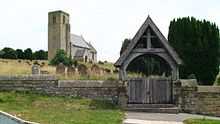Weaverthorpe
| Weaverthorpe | |
.jpg)
|
|
 Weaverthorpe | |
| OS grid reference | SE965708 |
|---|---|
| District | Ryedale |
| Shire county | North Yorkshire |
| Region | Yorkshire and the Humber |
| Country | England |
| Sovereign state | United Kingdom |
| Post town | MALTON |
| Postcode district | YO17 |
| Police | North Yorkshire |
| Fire | North Yorkshire |
| Ambulance | Yorkshire |
| EU Parliament | Yorkshire and the Humber |
| UK Parliament | Thirsk and Malton (formerly Ryedale) |
Weaverthorpe is a village and civil parish in the Ryedale district of North Yorkshire, England. It is 13 miles from Scarborough.
Weaverthorpe was listed as being in the wapentake of Buckrose.
Gypsey Race beck runs alongside the main street.
Bronze Age settlements have been found at nearby Cowlam. There was a vill on the site in the period of Viking/Norse settlement when it was known as Wifertorp (11th century). The village's name is linked to a certain Vidhfari, anglicized in Wivar. In the Domesday Book there is a mention of Wiveretorp in 1110. Same male's name as in Wiverton (Nottingham) and in the Vierville (Wiarevilla 1158), Virville (Wivarevilla v. 1210) and Viertot of Normandy. After the Norman conquest it was held by the Archbishop of York under Michael FitzHerbert. In the 12th century the church of St. Andrew was granted to Nostell Priory until 1268. Lucy, daughter of Piers FitzHerbert, married Sir William de Ros of Helmsley-in-Holderness [alias Hamlake) (died circa 1264) who acquired the manor of 'Wyverthorp'. In about 1271 the manor was acquired by William de Brewes, Baron Braose of Gower, on his marriage with Mary de Ros.[1]
Church of St. Andrew

The tower is reputed to be a mix of late Saxon and Norman in construction. The chancel is separated from the nave by a Norman arch. The font is probably Norman. Above the south door of the nave is a sun-dial, with a part-illegible fragment of an inscription in Saxon characters, claimed as reading: " In honore Sancti andre - Herbert W.... Hoc Monasterium ". It has been claimed as a memorial to Herbert de Winchester (died 1120/1130) who built the church. Herbert of Winchester was chamberlain to King Henry I. His son William FitzHerbert was granted by King John, the lands of "Launsborough, Collerthorpe, Wyderthorpe, Holperthorpe and the two Lottum" . The unexplained reference to "ecclesiam de Clera[m]" in the charter of King Stephen relating to "Wiverthorpe", might refer to a chapel attached to a local manor house.
A Victorian benefactor of Weaverthorpe, and landowner, was Sir Tatton Sykes.
During the Second World War, MI6 secretly installed a new type of direction finding station in a field just south of the village, it consisted of an underground metal tank with an aerial protruding above rotated by the operator inside the tank. The station was used to find the locations of German secret service radio stations and their spies in Europe (see www.secretlisteners.org).
References
- ↑ Magna Carta Ancestry: A Study in Colonial and Medieval Families By Douglas Richardson, Kimball G. Everingham Published 2005, Genealogical Publishing Com; p136
(Note: Interesting that William FitzHerbert was granted such lands by a king whose reign did not begin until 1199; when William, archbishop and saint, had died back in 1154.)
Bibliography
Gazetteers e.g.: "Bulmer's History and Directory of East Yorkshire (1892)"
External links
![]() Media related to Weaverthorpe at Wikimedia Commons
Media related to Weaverthorpe at Wikimedia Commons